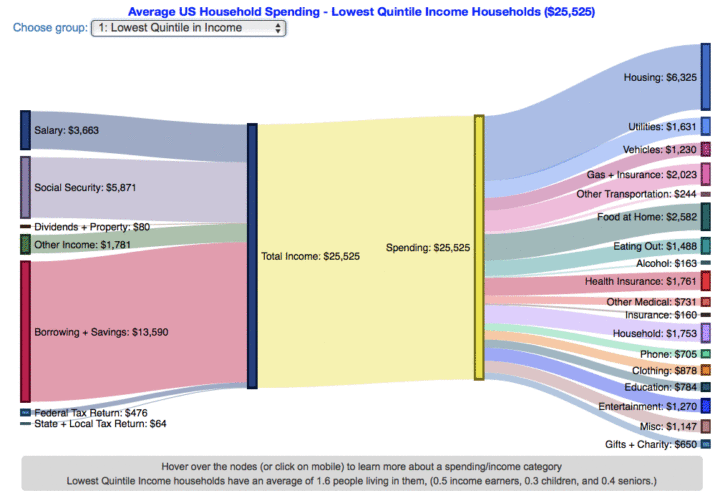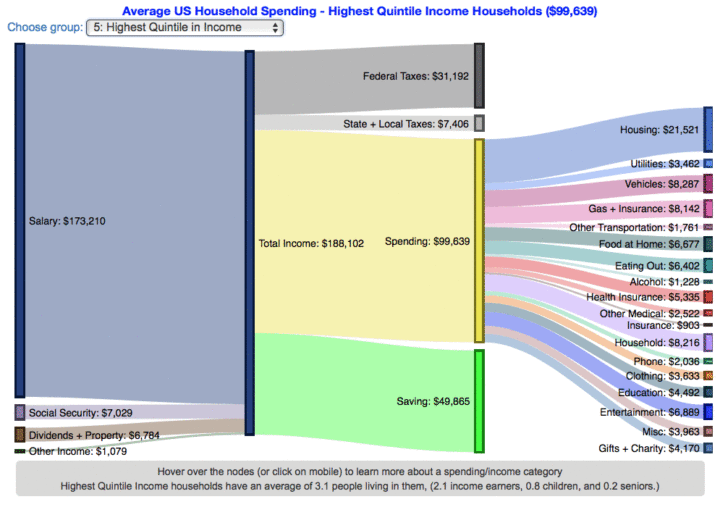Engaging Data has another neat visualization tool up, How do Americans Spend Money? US Household Spending Breakdown by Income Group, using household spending data from the US Bureau of Labor Statistics. Below is a screenshot of this interesting visualization technique (the full version is more interactive). The biggest contrast is seen when comparing the spending breakdown of the top 20% of income earners with the bottom 20%. (Click to enlarge.)
There are a lot of complex interactions going on inside this data visualization. Here are just a few things that I noticed:
- The average household in the bottom 20% of income only has 1.6 people and 0.5 income earners. The average household in the top 20% of income only has 3.1 people and 2.1 income earners. Is there any causation to this correlation? Does having a high income make you more likely to have a bigger household? Or do bigger households tend to make more money since there are more earners?
- The bottom 20% by income earns about $25,500 annually while saving absolutely nothing (and either spending down savings and/or going deeper into debt). The top 20% earns $188,000 and saves $50,000 of that annually. For the top 20%, that’s a savings rate of over 25%. Instead of a generic goal like saving 10% of your income, perhaps it is more appropriate to judge yourself by income group. Should a household earning around $200,000 a year expect to save $50,000 a year or be considered an “under-saver”? Or do the ultra-high income earners skew this savings number?
- The bottom 20% by income has the biggest chunk of their income from “Borrowing and Savings”. The top 20% has the vast majority of their income from salary and/or self-employment income. What is “Borrowing and Savings”? The tool says it could be students living off loans while in school, folks spending down cash savings during unemployment, or retirees drawing down savings. How much of this is people going into debt?
- If you only looked at the “average” of all households, you wouldn’t see this big difference. You would see a total income of $73,500 a year (mostly from a salary) and a relatively solid savings rate of about 13%.
Bottom line. You see a lot of statistics that use average or median numbers. However, I think that hides the fact that most people aren’t average. The top 20% and bottom 20% of households by income are leading very different lives, at least according to their spending patterns.
You can also view household spending breakdowns by age.


 The Best Credit Card Bonus Offers – 2025
The Best Credit Card Bonus Offers – 2025 Big List of Free Stocks from Brokerage Apps
Big List of Free Stocks from Brokerage Apps Best Interest Rates on Cash - 2025
Best Interest Rates on Cash - 2025 Free Credit Scores x 3 + Free Credit Monitoring
Free Credit Scores x 3 + Free Credit Monitoring Best No Fee 0% APR Balance Transfer Offers
Best No Fee 0% APR Balance Transfer Offers Little-Known Cellular Data Plans That Can Save Big Money
Little-Known Cellular Data Plans That Can Save Big Money How To Haggle Your Cable or Direct TV Bill
How To Haggle Your Cable or Direct TV Bill Big List of Free Consumer Data Reports (Credit, Rent, Work)
Big List of Free Consumer Data Reports (Credit, Rent, Work)
Interesting stuff.
About half of the people in the bottom 20% are people over 65 years old who spend down their retirement savings. You can find this from the BLS website.
Unemployed people would probably be a 1-3% of that bottom too.